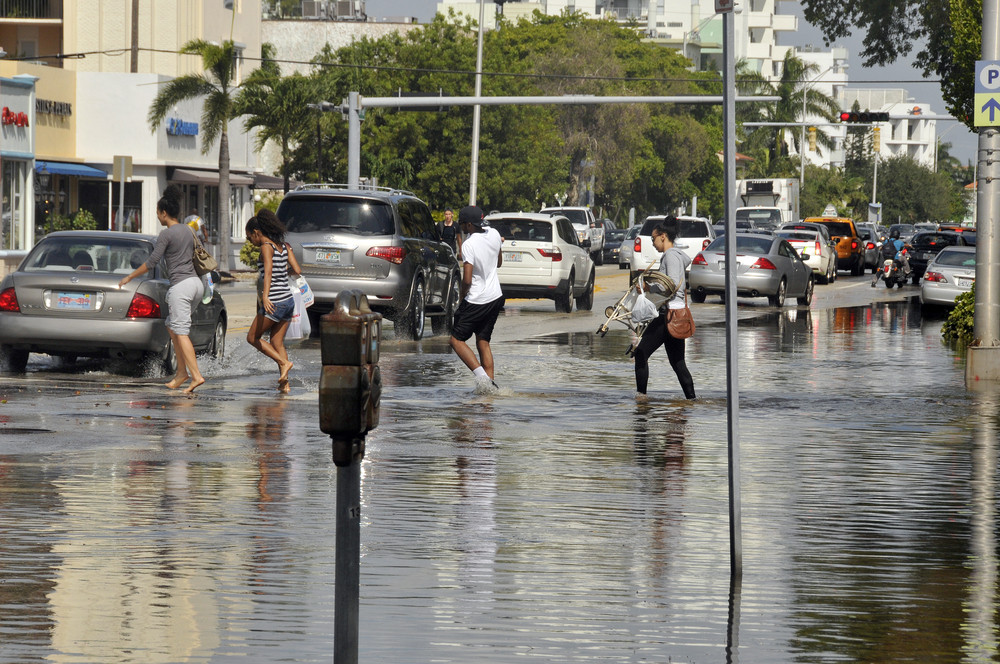The Latest Push for Cities That Are Both More Sustainable and Equitable
/flooding in miami. meunierd/ shutterstock:
How do we keep “sustainable community” from becoming synonymous with “gentrified community?” That’s a fraught question in major cities, where things like new park projects, light rail lines, bike lanes and electric vehicle charging stations tend to track with higher housing costs. And even as cities boast about steps to become greener, environmental justice advocates can feel marginalized as issues on their agenda—like dealing with toxins and pollution in vulnerable communities—get short shrift.
Funders focused on urban sustainability have become increasingly attuned to these equity issues, as we've been reporting. Conversations about two big national trends—inequality and urban revitalization—are intersecting in new ways within philanthropy. Last year, for example, we wrote about the Equity Pilot Initiative of the Funders’ Network for Smart Growth and Livable Communities. This is an effort to embed equity in local sustainability and climate action work. The Kendeda Fund and the Kresge Foundation took the lead there. Meanwhile, you can see a stronger equity angle in the network's Partners for Places grantmaking overall.
Partners for Places brings together local funders and public sector sustainability officers on sustainability and resilience projects. Through the Funders’ Network, a group of major funders—the JPB Foundation, the Kendeda Fund, the New York Community Trust, the Summit Foundation and the Surdna Foundation—provide money that local funders match.
This year’s Partners for Places grants, totaling nearly $900,000, very much incorporate an equity angle. Direct engagement with vulnerable communities is a particular focus, given the fact that low-income areas tend to be disproportionately affected by climate change. The six matching grants support work in Honolulu, Indianapolis, Los Angeles, Miami, Oak Park (IL), and Edmonton, Canada.
Related: Decision to Engage: Grants to Bring an Equity Lens to Urban Sustainability Work
What do some of these projects look like? In Indianapolis, the Central Indiana Community Foundation and Indianapolis Power & Light are supporting the recruitment of neighborhood “resilience ambassadors” to develop a sustainability plan for the city focusing on recently revitalized neighborhoods. Partners for Places backs similar community engagement in Honolulu, Los Angeles and Miami—cities that each face their own resilience challenges.
Other projects involve clean energy implementation, like Oak Park’s solar power campaign (through the Oak Park River Forest Community Foundation) that’ll include a teen-produced radio show to inspire other Chicago-area communities. Edmonton’s project also supports the transition to sustainable energy sources.
The grants are pretty modest, befitting their local nature, but what really stands out about Partners for Places is its potential to cement lasting relationships. From the beginning, the Funders’ Network has collaborated with the Urban Sustainability Directors Network (USDN), an organization for sustainability professionals in local government. And the matching support comes from community funders who often tend to operate at a distance from the public sector.
The hope is that this place-based partnership model will make it easier to advance local resilience and sustainability strategies, but in ways that are inclusive of low-income communities. Although this current round of grants doesn’t focus on parks, it’s worth noting that this is also an area that's become a focal point for new kinds of collaboration to green cities while also advancing equity.
Community-level grantmaking is becoming more interesting these days. We're seeing more partnerships between local and national foundations, often for work that brings together a range of stakeholders. A larger backdrop here is an acceleration in regional philanthropy in places well away from philanthropy’s traditional hotspots. While Partners for Places does fund in cities like L.A. and Miami, smaller places get these grants too. Establishing cross-sector relationships between growing local funders and sustainability advocates may end up yielding greater impact than the money itself.
Speaking of relationship building, Partners for Places is another example of how funder affinity groups can forge ties within philanthropy, as well as between funders and local actors. They’re a ready-made infrastructure for collaboration. Many affinity groups are also actively pushing conversations on equity. That’s another trend to keep an eye on as philanthropy confronts its own growth in an era of heightened political tension.
Related:







































